How to Hide Sketch Planes in Drawings
In SketchUp, section planes cut a model along a plane so that you can peer inside the model - without moving or hiding any geometry. In a 3D model, an active section plane hides everything on one side of the plane, equally shown in the post-obit effigy.

You can employ section planes for all types of applications:
- Cut a building horizontally to run into the floor plan. In architectural drawing, this two-dimensional summit-downwardly cut is called a planimetric view.
- Cut a building vertically to meet inside the rooms of several floors at once. This type of cutting is called a sectional view (not to be dislocated with SketchUp's section planes).
Tip: To create a planimetric view similar an architect, identify the section plane 48 inches above the floor's surface. This placement normally enables you to see windows and doors in the slice without cutting through countertops or article of furniture. To create a exclusive view, don't cut through columns, because they'll expect like walls instead of objects that people can walk effectually; exercise cut through stairs or elevators, because this shows how people motility through the edifice.
In SketchUp, you can insert multiple department planes, just only ane section aeroplane can be the agile cut in each context. Yous create more one context in a model by creating groups or components, each of which has a separate context. For example, the following model is a component and has ii section planes; the section airplane that shows the plan is agile.
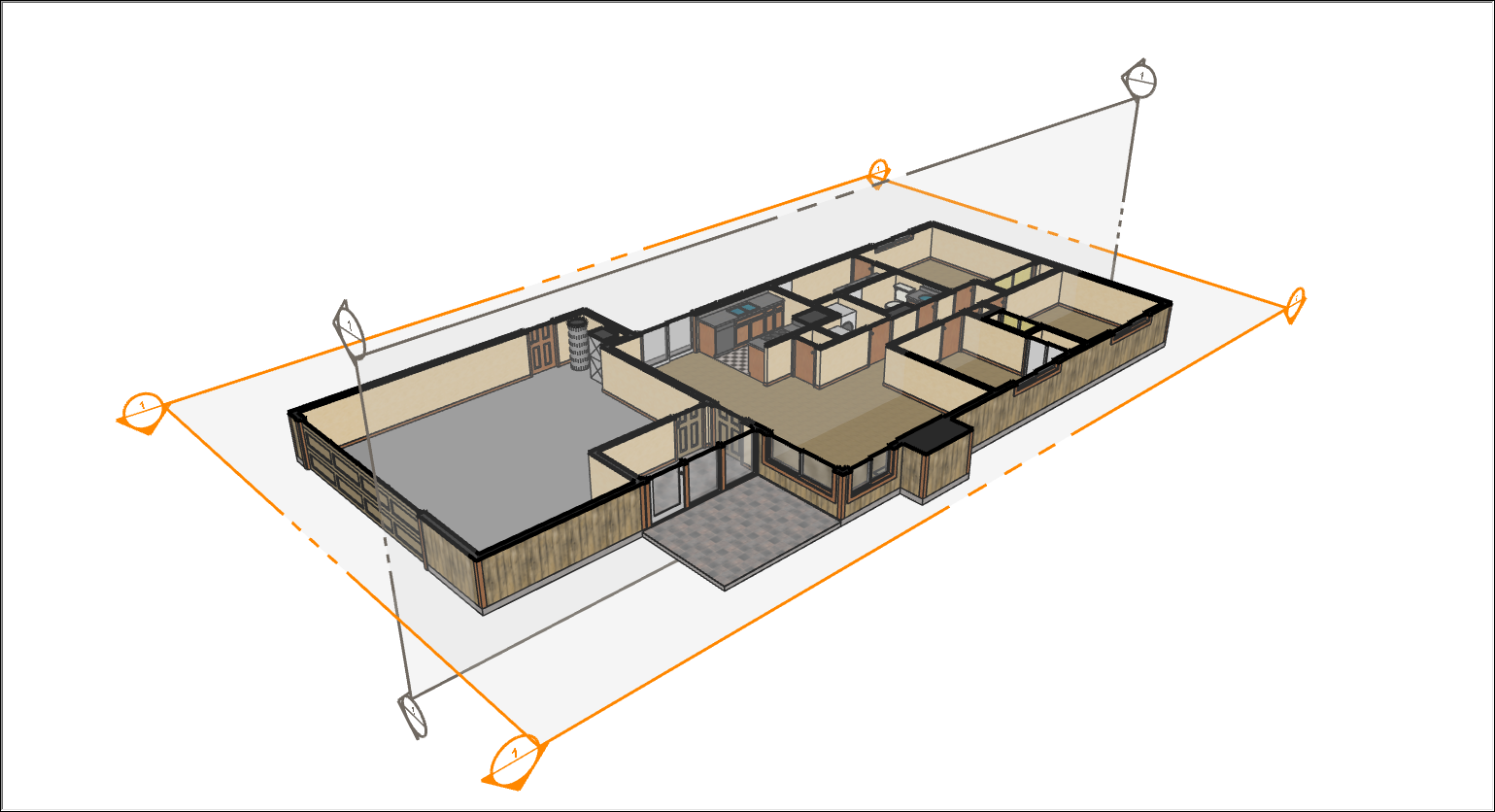
Another example is this model that contains several ovens. Each oven is a split group, as shown in the following figure. You can display an active section plane in each grouping to see that none of the ovens contains a warm apple tree pie or chocolate chip cookies. (Darn it!) See Grouping Geometry and Creating a Basic Component for details virtually creating groups or components and how to open or shut a group or component context.
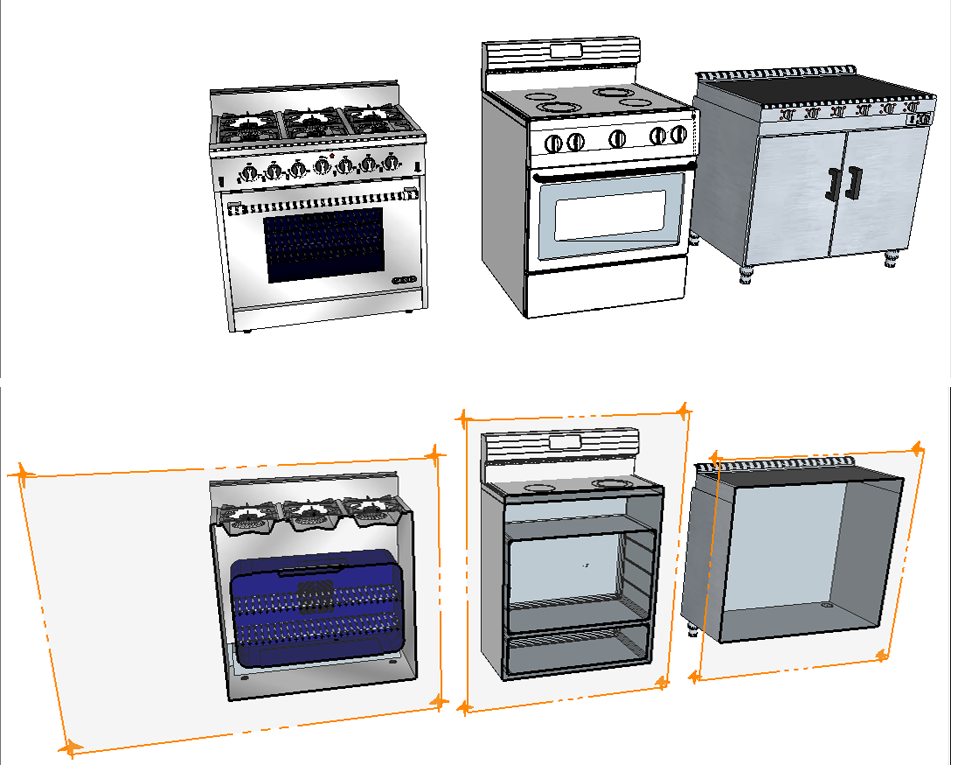
Tip: Want to bear witness off multiple interior views of a model? SketchUp enables you to show section cuts in scene animations. To animate scenes that show unlike section cuts, you demand to save the section settings in a mode and then save each view in a scene. Animating Scenes explains how to create animations of your model.
The post-obit video introduces y'all to department planes and gives you a sneak peek at section plane blitheness. In the upcoming sections, you observe detailed steps that walk you through the many things section planes can practise.
Table of Contents
- Adding a section plane
- Filling voids in section cuts
- Creating new geometry from a section plane
- Showing or hiding section planes, cuts, and fills
- Exporting section cut effects
Adding a department plane
Inserting a department plane is easy as pie. Brand sure aught in your model is selected, and open up the group or component context where you want to add the section plane. Besides, if you want to identify the section plane at a specific meridian, such as 48 inches higher up the floor surface, use the Record Mensurate tool to set a guide line that volition help you place the section plane precisely where you lot desire information technology.
When y'all're ready to add a department airplane, follow these steps:
- Select the Section Airplane tool (
 ) or select Tools > Section Plane. Microsoft Windows users find the Department Plane tool on the Sections toolbar. On both Microsoft Windows and Mac OS Ten, the Section Plane tool is on the Large Tool Ready palette.
) or select Tools > Section Plane. Microsoft Windows users find the Department Plane tool on the Sections toolbar. On both Microsoft Windows and Mac OS Ten, the Section Plane tool is on the Large Tool Ready palette. - With the section plane cursor, shown in the following figure, click a face to place your section plane.
Tip: If you have trouble keeping the section plane in your desired orientation, hover over a confront that matches the orientation yous want and agree down the Shift key to lock the section plane cursor's direction. You lot can too tap the arrow keys to orient the normal of the section plane to the default axes directions: Up for Blue axes, Right for Red axes, Left for Light-green Axes, and Downwardly for parallel to face.
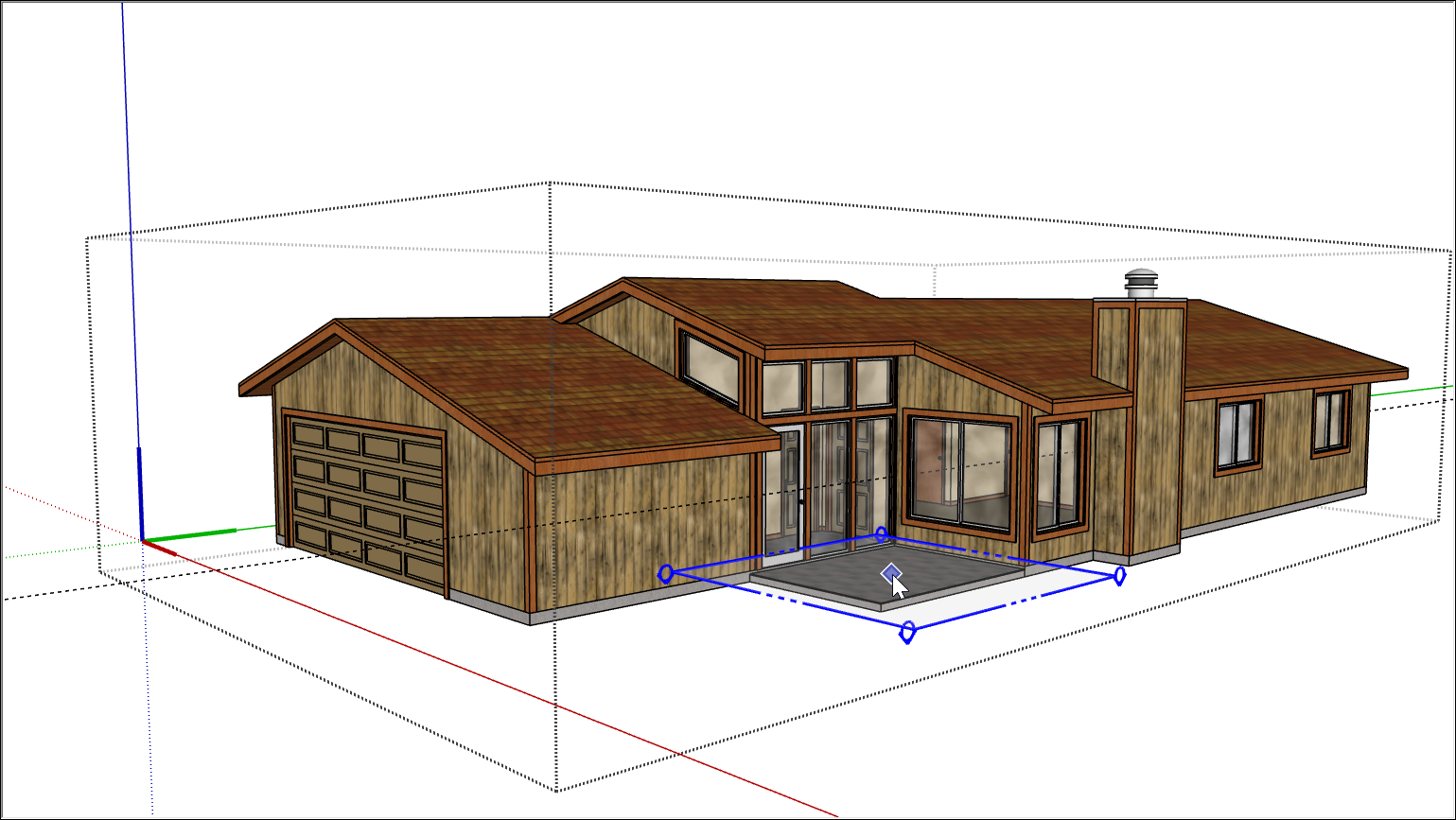

- Adjust the placement with the Movement tool or the Rotate tool.
- Reverse the cut direction by context-clicking the section plane and selecting Reverse from the menu that appears. For instance, if you make a vertical cut, you can opposite the cut to brandish the within of the other one-half of your building.
- Align SketchUp's photographic camera with the department airplane past context-clicking the department plane and selecting Marshal View. In the preceding effigy, aligning the view to your section plane takes you to a top view of the model.
- Select which section plane is the active cut, if you have more than i, by context-clicking the section plane you want to make agile and selecting Active Cutting from the bill of fare. Or, double-click the section plane you'd like to activate or deactivate.
- Control section plane visibility. See details about hiding or showing section planes later on in this commodity.
Tip: Want a quick style to manage your section planes? Each department plane appears in the Outliner console with the name you lot entered when y'all created the section plane. You can edit the section plane's name and symbol in the Outliner or the Entity Info panel.
In the Outliner, you can besides context-click a section plane and use the menu that appears to hibernate, actuate, opposite, and take other actions to manage that department plane. Double-clicking the name in the Outliner activates or deactivates the department plane.
Note: When you use the Align View command in Parallel Projection perspective, yous tin quickly generate sectional elevation or ane-point perspective views of your model.
Filling voids in section cuts
When y'all slice a solid with a section plane, you may not want to see voids where solid material should be. For example, say a section plane is showing a sliced concrete block. Depending on your department fill up settings, the model might show empty space where the concrete block would be filled.
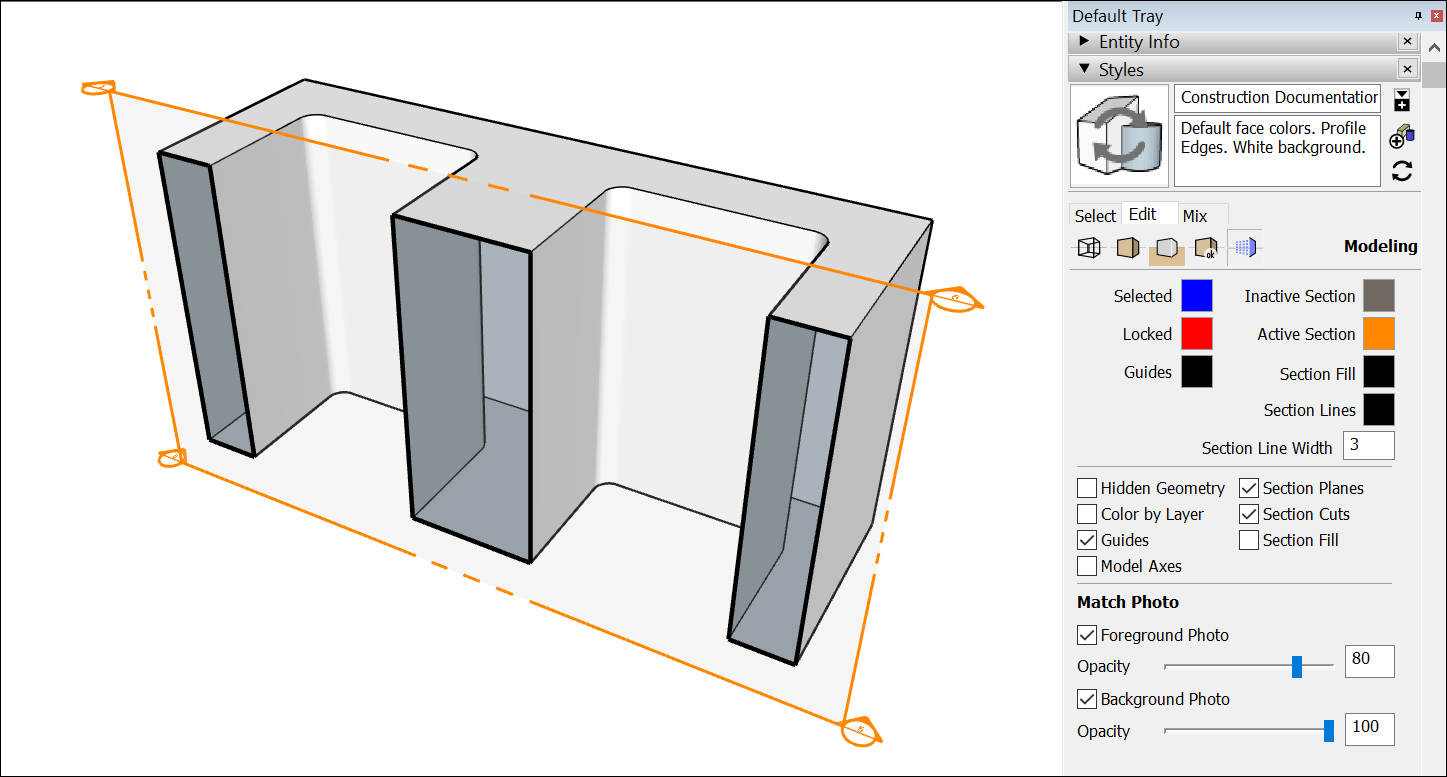
To fill closed loops in the slice, you can simply select the Department Fill bank check box in the Styles console. For example, the following figure shows how the concrete cake changes when the Department Make full cheque box is selected. Alternately, yous can toggle section fill visibility with the View > Section Fill command or the Display Section Make full button ( ) on the toolbar. (Recollect that whether you utilize the Styles panel, View carte, or toolbar buttons, yous change the style and demand to save the style if yous don't want to lose the visibility settings yous've applied.)
) on the toolbar. (Recollect that whether you utilize the Styles panel, View carte, or toolbar buttons, yous change the style and demand to save the style if yous don't want to lose the visibility settings yous've applied.)
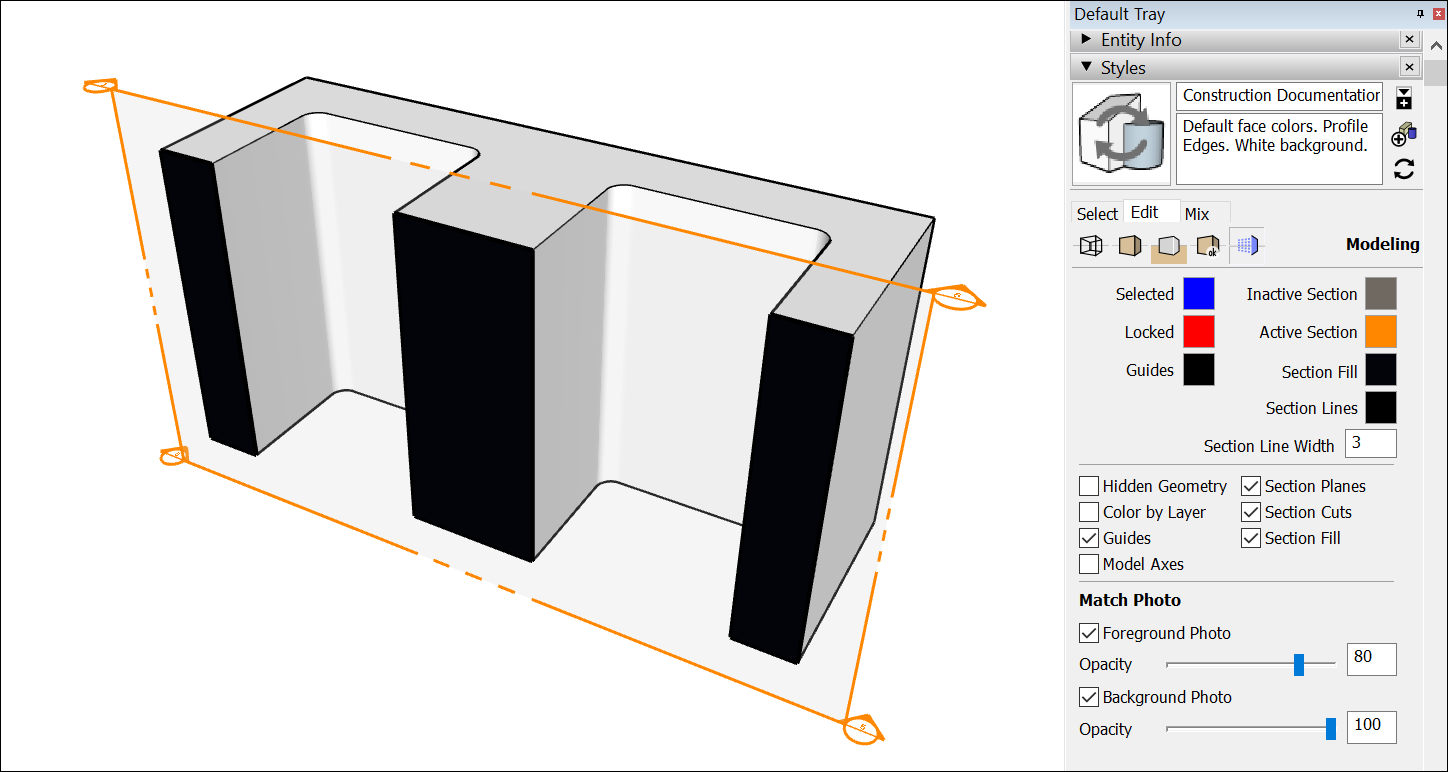
To control the Section Fill settings in the Styles panel, follow these steps:
- Open the Styles panel.
- Click the Edit tab.
- On the Edit tab, click the Modeling Settings icon (
 ).
). - To fill areas that are closed loops, select the Department Fill up check box. Remember that, to create a filled section cutting, the geometry in the section piece must course a closed loop inside its grouping or component hierarchy. You can encounter that bureaucracy in the Outliner.
- (Optional) To adjust the color, click the Section Fill color swatch and use the color picker to choose your desired colour.
Tip: Need some help troubleshooting a fill? Context-click the section aeroplane and cull Troubleshoot Section Fill. You and then see red circles around the vertices that edge the opening in the loop.
See Customizing Modeling Settings to Complement a Mode for more details about your Modeling Settings options.
Creating new geometry from a section aeroplane
Where a section aeroplane intersects with a model, SketchUp enables y'all to create geometry, which is automatically organized into a grouping. Yous can and then motility that group to a new location in your model, so you have a copy to piece of work with, as shown in the post-obit figure. Or explode the group so you tin can utilize the geometry to divide your model.
To create geometry in this way, context-click a department plane and select Create Group from Slice from the carte that appears.
Tip: If y'all have trouble seeing or selecting the group, select the group in the Outliner.
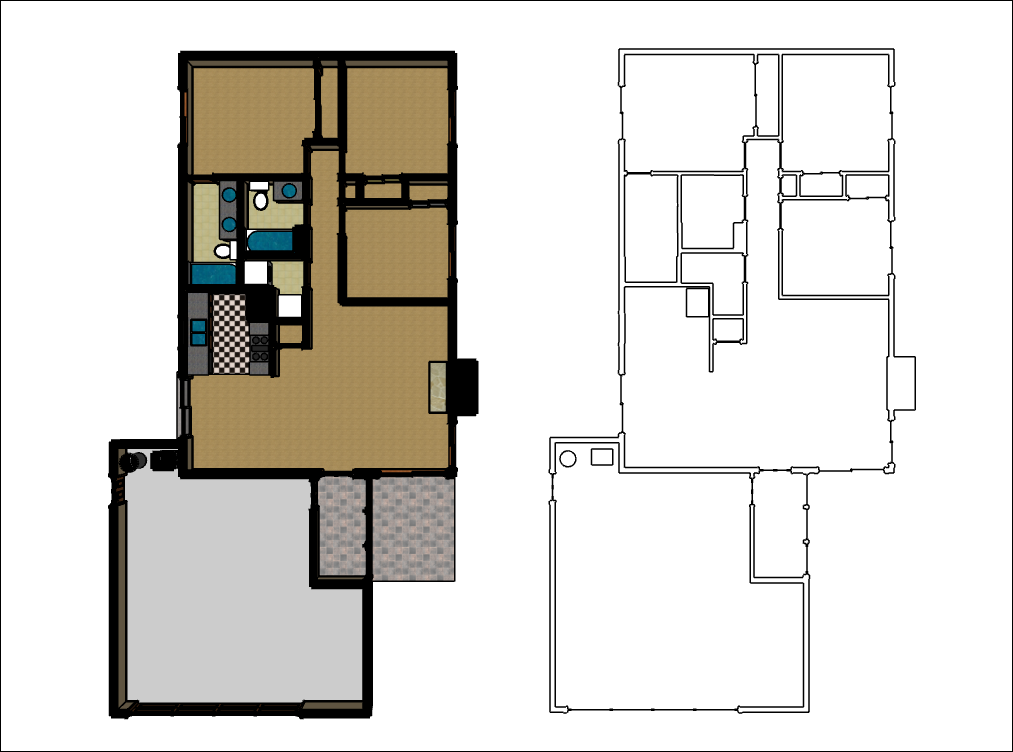
When a section airplane cuts your model, the cutting isn't permanent, and y'all can control the visibility of the plane and the cut independently of each other. Hiding the section aeroplane makes the transparent plane with its color handles disappear. Hiding the section cut makes your model await whole again.
Here's how to control the visibility of your section planes and cuts:
Tip: Microsoft Windows users can find all the department tools on the Section toolbar. Mac OS Ten users can add department tools to the primary toolbar. Come across Customizing Your Workspace for details.
Exporting section cut furnishings
No thing what version of SketchUp you accept (Make or Pro), y'all can export an image of your model displaying section cut effects. Y'all tin can use these images in portfolios, presentations, websites, or basically anywhere y'all might desire to prove off an prototype of your work. But make sure your model shows the section cut as you want it to announced in your image. See Using SketchUp Data with Other Modeling Programs or Tools for details about exporting a model as an image or other file type.
PROWith SketchUp Pro, you can too consign a section slice, which is a 2D vector epitome of geometry along a section plane. Here are a but a few ways you might use a section piece:
- Create scaled drawings in a CAD program. If you created a 3D model with precise measurements and angles, the section slice characteristic enables you to scale the piece. (Technically, you can scale imprecise models, besides; the calibration just doesn't hateful anything.)
- Edit the slice as a vector epitome. Because the 2D slice is exported every bit a vector graphic, you may exist able to open the exported file in programs like Adobe Illustrator.
Tip: When the calibration of your second slice is important, pay close attending to your view in SketchUp. If your view is fix to Perspective, you can't consign to scale. If you're viewing your model in Parallel Projection view, just faces whose normals are perpendicular to the view bending are measurable. Viewing a Model explains what the different views testify and how to change your view.
PRO To export a department slice from SketchUp Pro, follow these steps:
- If your section plane is within a group or component context, double-click the group or component to open up its context.
- Select the section plane with the section cut that you desire to export.
- Select File > Export > Section Piece. The Export 2D Section Slice dialog box appears, as shown in the following figure.
- Choose where you want to save the file. By default, the file is saved in your Documents folder.
- Blazon a name for the exported file in the File Name box (Microsoft Windows) or Save As box (macOS).
- Select what type of file you want to export from the Save As Type box (Microsoft Windows) or Format box (macOS). The default option is
.dwgor you can select.dxf. Both of these are AutoCAD file types. - (Optional) Click the Options button to open a dialog box where you lot can select your options. The following list outlines what your options mean. After you're washed selecting options, click OK to return to the Consign second Section Slice dialog box.
- Click the Export push. Your file is saved in the location you selected in Step 4.

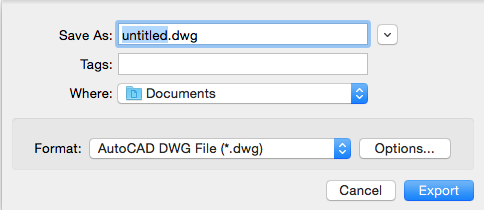
When you export a 2nd slice, yous can choose from the post-obit options:
- Truthful Section (Orthographic) exports the section slice as a true orthographic drawing. This is useful for creating templates for CAD drawings or any other time you want to generate accurate, measurable slices.
- Screen Projection projects the section cut as you lot come across it on your SketchUp screen, including any perspective distortion. This is most useful for diagrams that you don't need to measure out.
- AutoCAD Version enables you to select the version of AutoCAD you lot plan to use from the drop-downward listing.
- Drawing Scale and Size options enable you to configure the calibration of the exported section slice. If Full Scale is selected, SketchUp exports the file at a 1:1 calibration. The In Drawing and In Model options enable you to specify a drawing calibration, where In Drawing is the measurement of the exported geometry and In Model is the object's actual measurement. For case, for a scale of 1:iv, enter i" in the In Drawing box and 4" in the In Model box.
- Section Lines options enable you to choose how the department cut lines in your exported slice announced. None exports the lines at normal width. Polylines with Width turns the lines into polylines. Wide Line Entities (but available when exporting
.dwgfiles to AutoCAD 2000 or later) makes the lines in the exported file wider than normal. If you want to set the line width automatically, go out the Automatic checkbox selected. Or clear Automatic and enter a value in the Width box to set an verbal line width.
On Microsoft Windows, you also see Department Line options for separating profile edges on a layer and always being prompted for section slice options.
- The Split up on a Layer option creates a single additional layer for profile edges. This layer is useful if you would like to plot profile lines using a unlike pen weight or apace modify the line width of all profile lines in a separate CAD or illustration programme.
Tip: The Separate on a Layer pick is dissimilar from layer assignments in SketchUp. SketchUp Layer assignments do not translate straight when exporting 2nd hidden line vectors.
- Select the Always Prompt for Department Slice Options checkbox, and SketchUp displays the 2D Section Slice Options dialog box every fourth dimension you lot export a section slice. When this checkbox is cleared, by default, SketchUp uses whatever options were selected last fourth dimension.
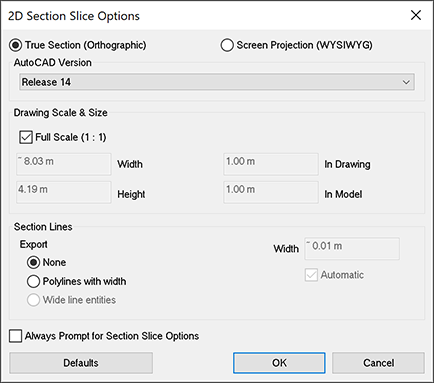

traviswitteorsell.blogspot.com
Source: https://help.sketchup.com/en/sketchup/slicing-model-peer-inside
Belum ada Komentar untuk "How to Hide Sketch Planes in Drawings"
Posting Komentar